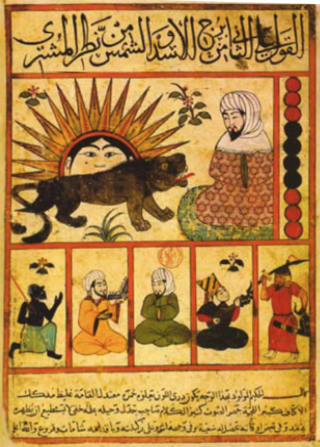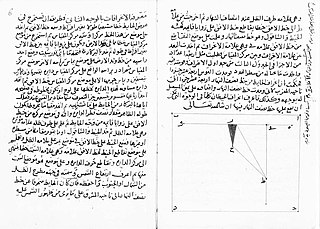
Abū ʿAbd Allāh Muḥammad ibn Jābir ibn Sinān al-Raqqī al-Ḥarrānī aṣ-Ṣābiʾ al-Battānī, usually called al-Battānī, a name that was in the past Latinized as Albategnius, was an astronomer, astrologer and mathematician, who lived and worked for most of his life at Raqqa, now in Syria. He is considered to be the greatest and most famous of the astronomers of the medieval Islamic world.

Abu al-Hasan 'Ali ibn 'Abd al-Rahman ibn Ahmad ibn Yunus al-Sadafi al-Misri was an important Egyptian astronomer and mathematician, whose works are noted for being ahead of their time, having been based on meticulous calculations and attention to detail.

Abu Ma‘shar al-Balkhi, Latinized as Albumasar, was an early Persian Muslim astrologer, thought to be the greatest astrologer of the Abbasid court in Baghdad. While he was not a major innovator, his practical manuals for training astrologers profoundly influenced Muslim intellectual history and, through translations, that of western Europe and Byzantium.

ʿAbu al-Ḥasan Alāʾ al‐Dīn bin Alī bin Ibrāhīm bin Muhammad bin al-Matam al-Ansari known as Ibn al-Shatir or Ibn ash-Shatir was an Arab astronomer, mathematician and engineer. He worked as muwaqqit in the Umayyad Mosque in Damascus and constructed a sundial for its minaret in 1371/72.

Plato Tiburtinus was a 12th-century Italian mathematician, astronomer and translator who lived in Barcelona from 1116 to 1138. He is best known for translating Hebrew and Arabic documents into Latin, and was apparently the first to translate information on the astrolabe from Arabic.

Medieval Islamic astronomy comprises the astronomical developments made in the Islamic world, particularly during the Islamic Golden Age, and mostly written in the Arabic language. These developments mostly took place in the Middle East, Central Asia, Al-Andalus, and North Africa, and later in the Far East and India. It closely parallels the genesis of other Islamic sciences in its assimilation of foreign material and the amalgamation of the disparate elements of that material to create a science with Islamic characteristics. These included Greek, Sassanid, and Indian works in particular, which were translated and built upon.
Ibn al‐Bannāʾ al‐Marrākushī, full name: Abu'l-Abbas Ahmad ibn Muhammad ibn Uthman al-Azdi al-Marrakushi, was a Maghrebi Muslim polymath who was active as a mathematician, astronomer, Islamic scholar, Sufi and astrologer.
Zīj-i Sulṭānī is a Zij astronomical table and star catalogue that was published by Ulugh Beg in 1438–1439. It was the joint product of the work of a group of Muslim astronomers working under the patronage of Ulugh Beg at Samarkand's Ulugh Beg Observatory. These astronomers included Jamshid al-Kashi and Ali Qushji, among others.
Abū al-Fath Abd al-Rahman Mansūr al-Khāzini or simply al-Khāzini was an Iranian astronomer of Greek origin from Seljuk Empire. His astronomical tables written under the patronage of Sultan Sanjar is considered to be one of the major works in mathematical astronomy of the medieval period. He provided the positions of fixed stars, and for oblique ascensions and time-equations for the latitude of Marv in which he was based. He also wrote extensively on various calendrical systems and on the various manipulations of the calendars. He was the author of an encyclopedia on scales and water-balances.
Medieval Islamic geography and cartography refer to the study of geography and cartography in the Muslim world during the Islamic Golden Age. Muslim scholars made advances to the map-making traditions of earlier cultures, particularly the Hellenistic geographers Ptolemy and Marinus of Tyre, combined with what explorers and merchants learned in their travels across the Old World (Afro-Eurasia). Islamic geography had three major fields: exploration and navigation, physical geography, and cartography and mathematical geography. Islamic geography reached its apex with Muhammad al-Idrisi in the 12th century.
Ṣāʿid al-Andalusī, in full Abū al-Qāsim Ṣāʿid ibn Abū al-Walīd Aḥmad ibn Abd al-Raḥmān ibn Muḥammad ibn Ṣāʿid ibn ʿUthmān al-Taghlibi al-Qūrtūbi, was an Arab qadi of Toledo in Muslim Spain, who wrote on the history of science, philosophy and thought. He was a mathematician and scientist with a special interest in astronomy and compiled a famous biographic encyclopedia of science that quickly became popular in the empire and the Islamic East.

A Dar al-Muwaqqit, or muvakkithane in Turkish, is a room or structure accompanying a mosque which was used by the muwaqqit or timekeeper, an officer charged with maintaining the correct times of prayer and communicating them to the muezzin. Dar al-Muwaqqit was the Arabic term given to such structures added to many mosques in Morocco from the Marinid period onward. In the Ottoman Empire the equivalent of such structures were known in Turkish as a muvakkithane.
Louis-Pierre-Eugène Amélie Sédillot, was a French orientalist and historian of science and mathematics.
Abū al‐ʿUqūl Muḥammad ibn Aḥmad al‐Ṭabarī was a leading astronomer in Ta'izz and the first teacher of astronomy at the Muʾayyadiyya Madrasa. Of Iranian origin, he is known for compiling the largest single corpus of tables for astronomical timekeeping in a specific latitude during medieval times, with over 100,000 entries. Another interesting feature of his work was determining the latitude of Ta'izz as 13° 37'.

ʿAbū ʿAlī al‐Ḥusayn ibn Muḥammad al‐Ādamī was a maker of scientific instruments who wrote an extant work on vertical sundials, Techniques, Walls, and the Making of Sundials. The manuscript, which is held in the Bibliothèque nationale de France, contains tables that enabled the drawing of lines to show any desired angle of latitude. The surviving copy of al-Adami's 10th century manuscript (Arabe 2506,1 dates from the 15th century, which King has suggested was written either by al-Adami or by a contemporary, Sa'id ibn Khafif al-Samarqandi. The tables on folios. 31v–33v were intended to be used in the construction of a vertical sundial.
Najm al‐Dīn al‐Miṣrī was a 14th-century Egyptian astronomer mostly known for writing a large astronomical table that had nearly 415,000 entries. The table is considered to be the largest of its kind ever produced by one person during the Middle Ages. Although the main purpose of the work was astronomical timekeeping, it can also be used to solve all problems of spherical trigonometry by changing the arguments of the table. Najm al‐Din also wrote an important illustrated treatise that describes more than 100 different astronomical instruments, such as astrolabes, quadrants and sundials, including ones he invented himself. This work is of high importance for modern scholars and one of the main sources on the subject.

In the history of Islam, a muwaqqit was an astronomer tasked with the timekeeping and the regulation of prayer times in an Islamic institution like a mosque or a madrasa. Unlike the muezzin who was usually selected for his piety and voice, a muwaqqit was selected for his knowledge and skill in astronomy.

Mustafa ibn Ali al-Muwaqqit, also known as Müneccimbaşı Mustafa Çelebi and Koca Saatçi, was an Ottoman astronomer and author of geography from the sixteenth century. Because of his works on the science of timekeeping and practical astronomy, he is considered "the founder of the Ottoman tradition" of those fields. He was one of the pioneers of astronomy literature in Ottoman Turkish—instead of Arabic which was more common in the Islamic world—following Muhammad al-Qunawi. Since his youth he served as the muwaqqit attached to the Mosque of Selim I in Istanbul, in which capacity he produced most of his writing. In 1560 or later he was appointed to the office of müneccimbaşı, the highest post for astronomers of the Empire.

Muhammad ibn al-Katib Sinan al-Qunawi, also known as Muhammad ibn Yusuf, was an Ottoman astronomer and muwaqqit (timekeeper) in the late fifteenth and early sixteenth century. A pioneer of Ottoman astronomy, especially in the field of astronomical instruments and timekeeping, he served as muwaqqit at various mosques, and eventually at the Sublime Porte under Suleiman the Magnificent. He was influenced by earlier Mamluk astronomers, especially Shams al-Din al-Khalili (1320–1380) and Ibn al-Shatir, as well as by the Central Asian Ali al-Qushji and Al-Biruni.











